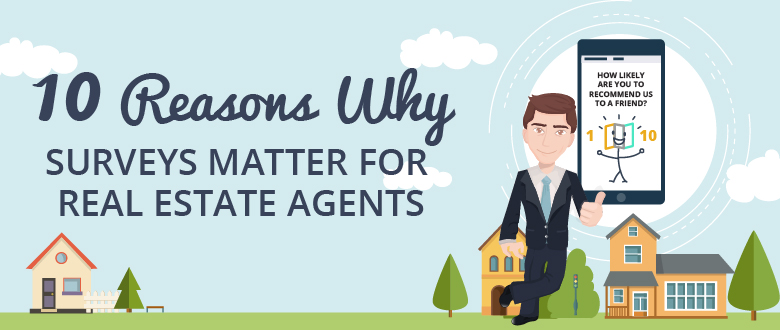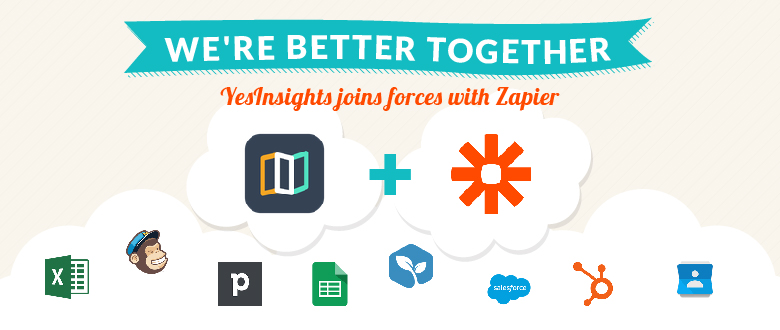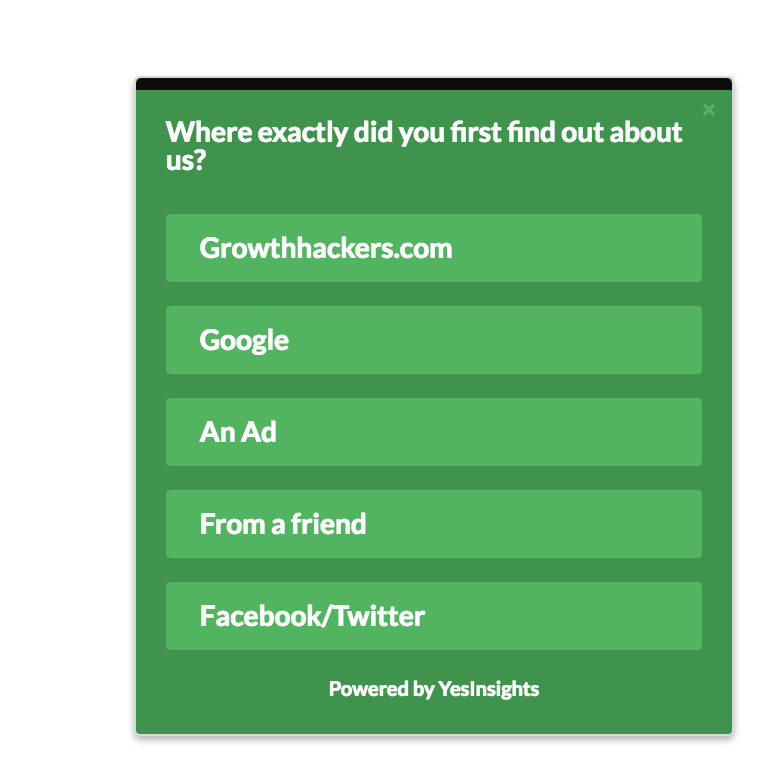Hosting a webinar is one of the best ways to make more sales, grow your brand, and reach more potential customers. One of the biggest mistakes that I see a lot of marketers and founders make is not following up with their attendees after the webinar. A simple webinar follow up email can make the difference between a warm lead and a missed opportunity.
Nothing would be more frustrating than putting all the time and effort into putting together a long webinar without any solid conversion results. The truth is that not all your attendees will convert and turn into a paying user. But there are a lot of things you can do to maximize the results.
- Follow up with your attendees and evaluate if they are converting.
- If they are not converting, figure out why.
Now, let’s talk best practices and how you can do this.
Send a webinar follow-up email within 24 hours
It’s no secret. Most attendees will watch multiple webinars in a work week. Chances are that they forgot about your company and the webinar that they watched recently. This is why it’s important to follow up while the webinar is still fresh in their mind. In addition to that, a lot of people actually register for webinars but never end up watching it. It happens all the time.
A while back I registered for a webinar and forgot about it despite all the reminder emails that they sent out. Here’s a follow-up email that I received from the host.
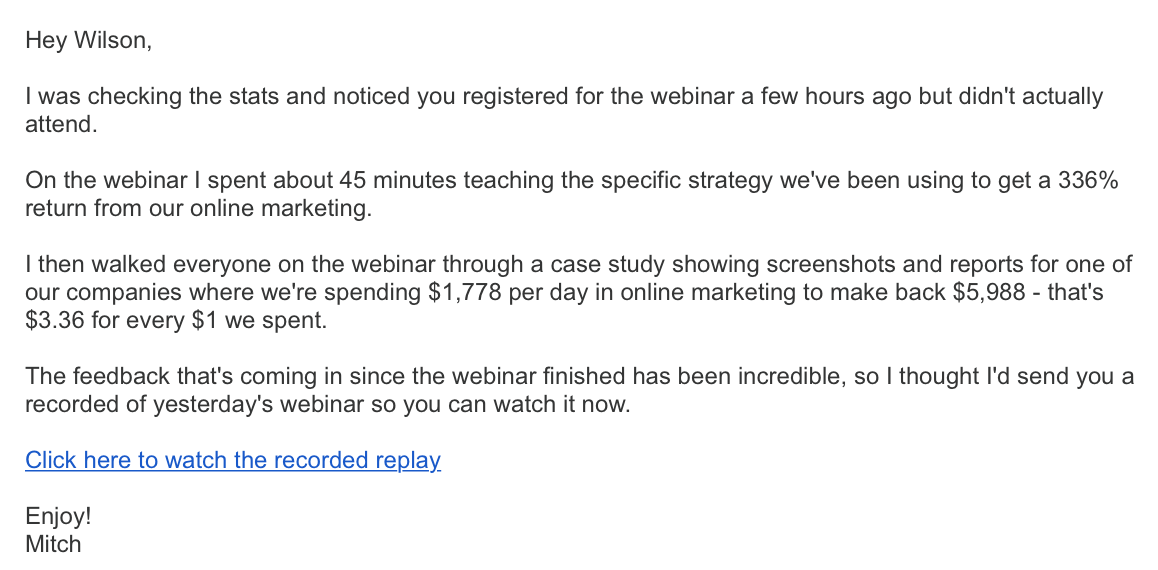
What’s awesome about this email is that it is personalized, short, includes a replay, and most importantly segmented. The host segmented his attendee list and tracked all the people who did not attend the webinar. The host then sent out an email with a replay link, so that you can still watch the webinar and gain value of it.
Here’s another one created by SilverPop for people that actually attended the webinar:
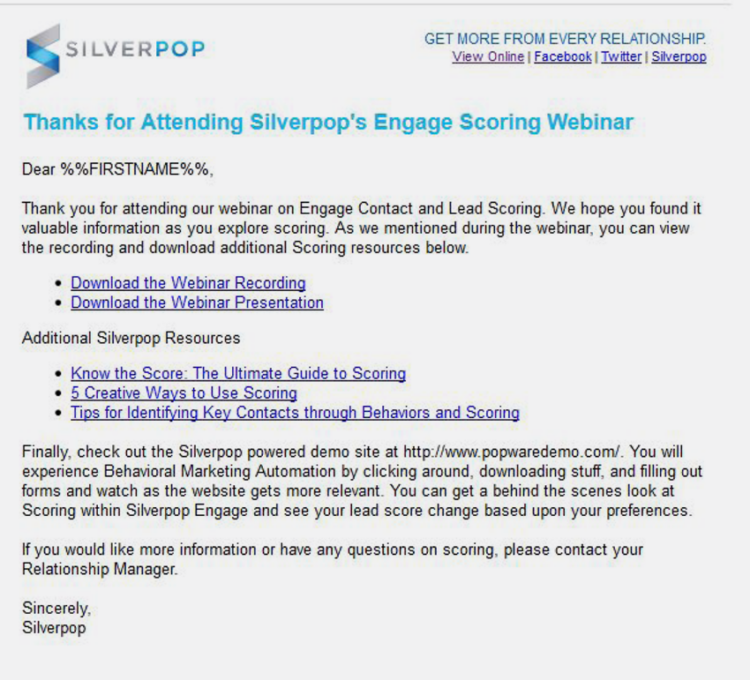
This email is really well written as well. It provides links to the replay and the presentation. They also included additional resources for people who still remember the content from the webinar and just want to learn more. Lastly, they included a call to action for a demo.
With a video on Youtube or any other video hosting service, anyone can view it and skim through the webinar, but it isn’t the same with live webinars. Attendees don’t have the option to skim through it, so a replay is always nice. This allows the attendees to refresh their minds.
Add a survey to your webinar follow up emails
The first follow up email that goes out should always be a replay or additional educational resources, but the best marketers and sales people know that this isn’t enough. You have to constantly engage with your leads and consistently follow up.
The email that you should send right after should be an embedded email survey. For example, we hosted a webinar titled, “User Onboarding Best Practices”. You can watch the replay on Youtube here if you’re interested in optimizing your onboarding process to convert more trial leads. We had a good amount of people register for the webinar but most of them did attend. Even fewer people converted. I had to figure out why they weren’t converting. A bunch of questions came to my mind:
- Was our content not valuable enough?
- Did we not provide enough information?
- Did we target the wrong market?
- Maybe our product isn’t good enough?
Of course, I had a lot more questions, so I decided to send out a simple one-click survey to gain actionable feedback and improve our future webinars. The email that I sent out looked like this:
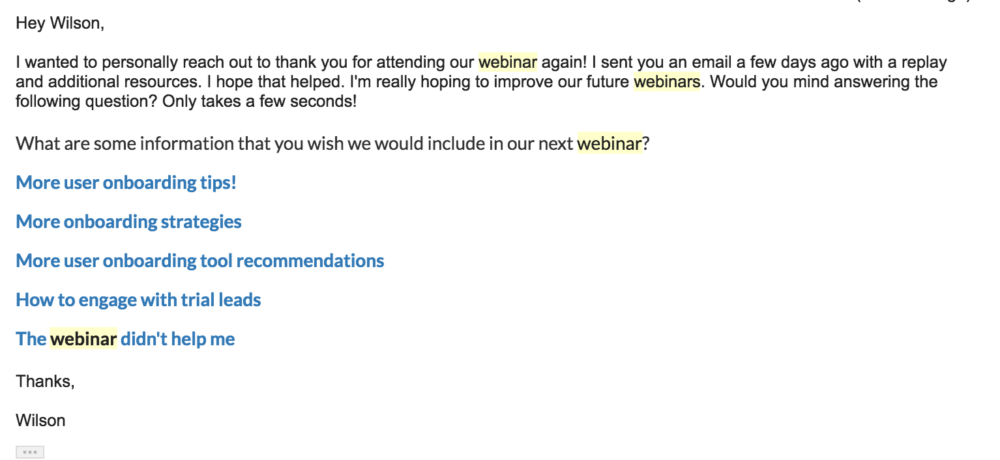
With this simple question, I’m able to narrow down what worked and what didn’t work. Most importantly, I’m able to the guesswork out of figuring out what the majority of attendees really wanted from the webinar. The powerful thing about a survey like this is that I can send this as a pre-webinar survey as well as a post-webinar survey. Actionable feedback is a key to success for making more informed business decisions.
If you’re stuck with the right questions to ask, this post should help you come up with new ideas: “Try Asking Your Customers These Questions To Come Up With New Growth Hacks”
I created this simple one-click survey with YesInsights. To set this up, you can simply create an account on YesInsights, log into the dashboard and click create a survey on the top right.

You’ll be asked to fill out the data to include in your survey as well as you’ll be able to set auto follow-up emails for after your survey is answered. You’ll also have the option to use the YesInsights landing page asking for additional comments or designing a custom landing page:
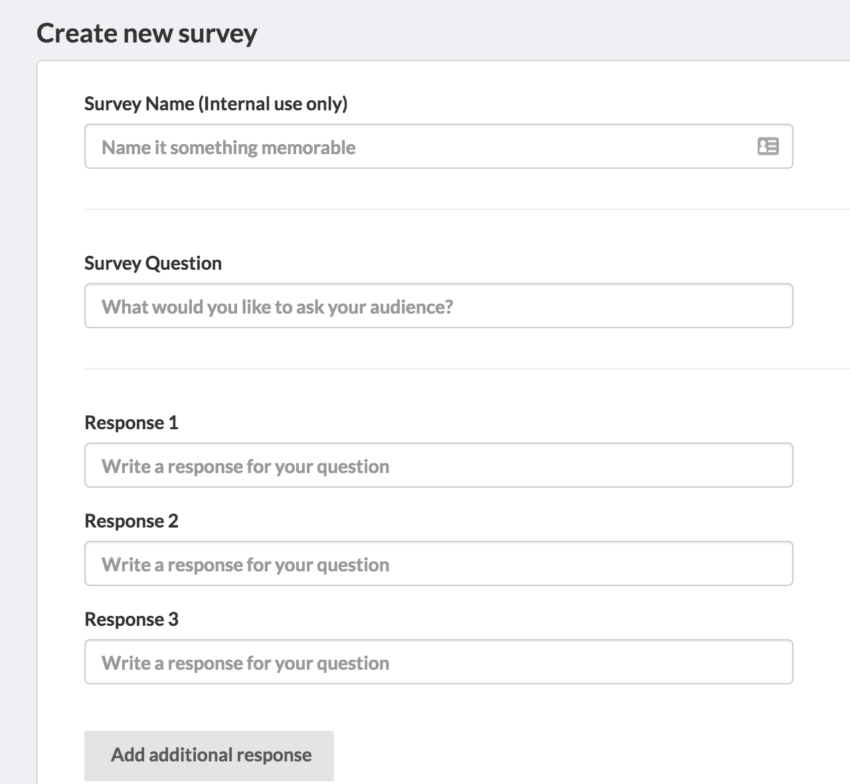
Next, you’ll be prompted to copy and paste a simple survey into your email client. YesInsights integrates with over 30 email providers including Gmail, MailChimp, GotoWebinar, Zapier, Leadpages and any other service you use for your webinar.
Boom! It was that simple and takes less than a minute to set up. During the survey set up process, I designed a custom landing page where the respondent can add additional comments. Those additional comments help me gain more actionable feedback and hear the voice of the customer.
I learned a lot from sending this simple survey. Luckily, none of the attendees selected, “The webinar didn’t help me”, but most did select “How to engage with trial leads”. This is important because we didn’t cover much onboarding engagement tips in the webinar.
This type of survey is considered to be a one-click or inline surveys. This works really well because it reduces the barrier to entry for respondents and it doesn’t ruin the user experience. Usually, one-click surveys get up to 80%+ response rates compared to traditional surveys.
Another survey question that might help you would be asking the attendee for their role in their company. This will allow you figure out if you targeted the correct people for the webinar. Extremely helpful, especially if you’re spending money on acquiring users for the webinar.
The best practice for sending a follow-up email with a survey is approximately 2-3 days after you’ve sent the initial follow-up reply.
You can get creative with the survey questions. For example, you might want to send a Net Promoter Score survey after the webinar to see how likely the attendee will recommend your webinar to a friend and then auto trigger an email with a referral replay link. Let your imagination and creativity get wild!
Include a call to action
Most people already know the importance of including a call to action to the end of emails. If you’re a software company, this might be a demo or a free trial to your product. Most people like to offer discounts at the end of their webinar or a special code for people to opt in for a free trial. It’s extremely vital to include this in your follow up email.
I remember that I attended a webinar session for a customer success program a while back. Towards the end of the webinar, the host was offering a free 14-day trial to anyone that watched the webinar. It included some discount code that I totally forgot about. A few days later, I received an email with the same discount code again as a reminder. I applied it to my check out page immediately and gave the program a try.
This might not be the case for everyone that is running a webinar. For example, you might be a service business. Or you might be offering a free course. Or perhaps a coaching program. Regardless of what it is, ensure that you include a call to action leading to your end results.
I received another email with an offer to his coaching program a few days after I received the original email (above) from Mitch. The email looked like this:
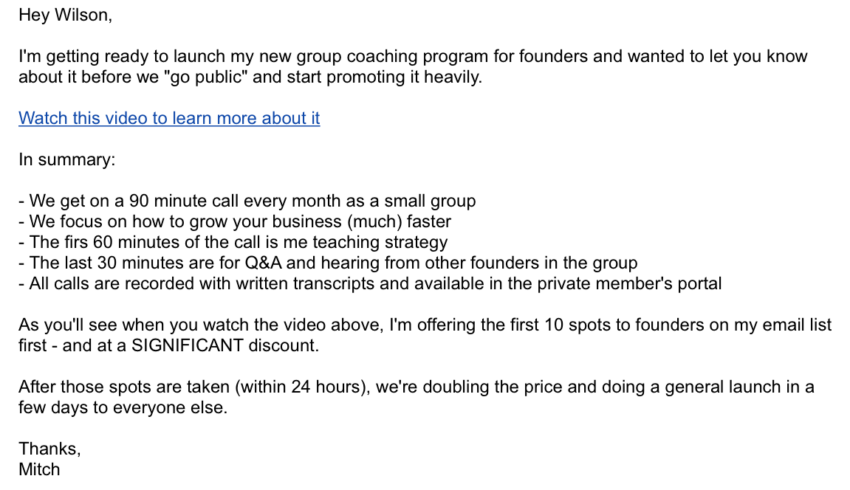
I love how Mitch included a summary of what you can actually get from his coaching program. I get a lot of emails every day with random links. And I don’t bother to click on most of them, but a brief summary of bullet points is effective.
The second thing that Mitch did really well is how he created a sense of urgency in this email. Notice how he said that he’s only offering the first 10 spots to founders on my email list with a discount. He also mentioned that you only have 24 hours to opt in!
One last tip! Make sure that you continue to engage with your attendees post webinar. So that means that your follow-up emails should not be only 2 or 3 emails. Instead, continue to send them additional resources as well as offer free help. Building relationships with customers goes a long way! And nurturing leads is one of the best ways to get referrals even if the particular attendee isn’t interested in your product.
There you have it! If you want to get started right away, sign up for a free 7-day trial with YesInsights to take the next step forward.

